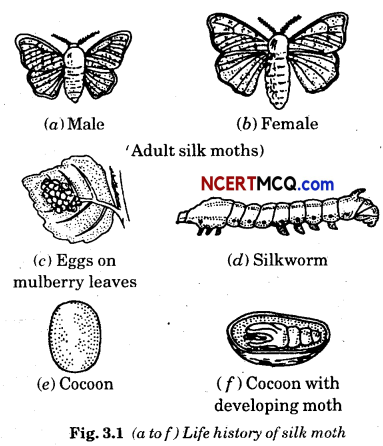Check the below Online Education NCERT MCQ Questions for Fibre to Fabric Class 7 Extra Questions and Answers Science Chapter 3 Pdf free download. https://ncertmcq.com/extra-questions-for-class-7-science/
Online Education for Class 7 Science Chapter 3 Extra Questions and Answers Fibre to Fabric
Fibre To Fabric Class 7 Questions And Answers Question 1.
Name three animals that yield wool.
Answer:
Sheep, goat, yak.
Fibre To Fabric Class 7 Extra Questions And Answers Question 2.
In which areas are yaks found in plenty?
Answer:
Tibet and Ladakh.
Class 7 Science Chapter 3 Extra Question Answer Question 3.
Which animal provides Pashmina shawls?
Answer:
Kashmiri goat.
Ncert Solutions For Class 7 Science Chapter 3 Extra Questions Question 4.
What is the diet of sheep?
Answer:
Grass, leaves, mixture of pulses, corn, jowar, oil cakes and minerals.
![]()
Class 7 Science Chapter 3 Extra Questions Question 5.
In which season sheep are sheared?
Answer:
Summer.
Class 7 Fibre To Fabric Extra Questions Question 6.
What are burrs?
Answer:
Small fluffy fibres found in hair of sheep are called burrs.
Ncert Class 7 Science Chapter 3 Extra Questions Question 7.
What are silkworms?
Answer:
Larvae of silk moth are called silkworms.
Fibre To Fabric Class 7 Worksheet With Answers Question 8.
Name one disease that occurs in sheep.
Answer:
Anthrax. It is a fatal blood disease.
Class 7 Science Ch 3 Extra Questions Question 9.
What is cocoon?
Answer:
For pupa stage, the caterpillar completely covers itself by silk fibres. This covering is known as cocoon.
Class 7 Chapter 3 Science Extra Questions Question 10.
What is the most common silk moth?
Answer:
Mulberry silk moth.
Fibre To Fabric Class 7 Questions And Answers Pdf Question 11.
What is selective breeding?
Answer:
The process of selecting parents for obtaining special characters in their offspring is termed ‘selective breeding’.
![]()
Fibre To Fabric Class 7 Extra Questions Question 12.
Write about the food of sheep.
Answer:
Apart from grazing sheep, rearers also feed them on a mixture of pulses, corn, jowar, oil cakes (material left after taking out oil from seeds) and minerals. In winter, sheep are kept indoors and fed on leaves, grain and dry fodder.
Questions On Fibre To Fabric Class 7 Question 13.
How is reeling of silk done?
Answer:
Reeling is done with special machines, which unwind the threads or fibres of silk from the cocoon. Silk fibres are then spun into silk threads.
Extra Questions Of Fibre To Fabric Class 7 Question 14.
How is shearing of wool done?
Answer:
Machines similar to those used by barbers are used to shave off hair. Usually, hair are removed during the hot weather. This enables sheep to survive without their protective coat of hair. The hair provide woollen fibres. Woollen fibres are then processed to obtain woollen yarn. Shearing does not hurt the sheep because uppermost layers of skin is dead.
Class 7 Science Fibre To Fabric Extra Questions Question 15.
How is silk processed?
Answer:
A pile of cocoons is used for obtaining silk fibres. The cocoons are kept under the sun or boiled or exposed to steam. The silk fibres are separate out. The process of taking out threads from the cocoon for use as silk is called reeling the silk. Reeling is done in special machines, which unwind the threads or fibres of silk from the cocoon. Silk fibres are then spun into silk threads, which are woven into silk cloth by weavers.
Chapter 3 Science Class 7 Extra Questions Question 16.
How is woollen cloth made after scouring hair of sheep?
Answer:
After scouring, sorting is done. The hairy skin is sent to a factory where hair of different textures are separated or sorted. The small fluffy fibres, called burrs, are picked out from the hair. The fibres are scoured again and dried. This is the wool ready to be drawn into fibres.
The fibres can be dyed in various colours, as the natural fleece of sheep and goats is black, brown or white.
The fibres are straightened, combed and rolled into yarn. The longer fibres are made into wool for sweaters and the shorter fibres are spun and woven into woollen cloth.
![]()
Fibre To Fabric Extra Questions Class 7 Question 17.
Describe the life history of silk moth.
Answer:
The female silk moth lays eggs, from which hatch larvae which are called caterpillars or silkworms.
- They grow in size and when the caterpillar is ready to enter the next stage of its life history called pupa, it first weaves a net to hold itself.
- Then it swings its head from side to side in the form of the figure of eight (8). During these movements of the head, the caterpillar secretes fibre made of a protein which hardens on exposure to air and becomes silk fibre.
- Soon the caterpillar completely covers itself by silk fibres. This covering is known as cocoon.
- The further development of the moth continues inside thte cocoon.
- Finally, it comes out of the cocoon as silk- moth.
Fiber To Fabric Class 7 Questions And Answers Question 18.
Draw figures to describe life history of silk moth.
Answer:

Class 7th Science Chapter 3 Extra Questions Question 19.
How is rearing of silkworms done?
Answer:
A female silk moth lays hundreds of eggs at a time. The eggs are stored carefully on strips of cloth or paper and sold to silkworm farmers.
- The farmers keep eggs under hygienic conditions and under suitable conditions of temperature and humidity.
- The eggs are warmed to a suitable temperature for the larvae to hatch from eggs. This is done when mulberry trees bear a fresh crop of leaves. The larvae, called caterpillars or silkworms, eat day and night and increase enormously in size.
- The worms are then kept in clean bamboo trays along with freshly chopped mulberry leaves.
- After 25 to 30 days, the caterpillars stop eating and move to a tiny chamber of bamboo in the tray to spin cocoons. Small racks or twigs may be provided in the trays to which cocoons get attached. The caterpillar or silkworm spins the cocoon inside which develops the silk moth.
Extra Questions On Fibre To Fabric Class 7 Question 20.
Boojho is wondering why it hurts when someone pulls his hair but not when he goes for a haircut?
Answer:
When someone pulls our hair, it hurts because its root is connected to the skin which has sensation. But, during haircut, the tip of the hair is cut which is dead and does not have any sensation. So, hair-cut does not hurt.
Question 21.
Boojho is wondering why a cotton garment cannot keep us as warm in winter as a woollen sweater does?
Answer:
Cotton clothes are thin and do not trap air tool is thicker than cotton and have spaces in which air traps. Air is a poor conductor of heat and so it prevent heat coming out of our body. So, woo’ provides better warmth than cotton.
Question 22.
What is meant by the following terms?
(i) Rearing
(ii) Shearing
(iii) Sericulture
Answer:
(i) Rearing: The bringing up and looking after the livestock and other animals for our commercial benefit is known as rearing.
(ii) Shearing: To obtain wool, the fleece of the sheep along with a thin layer of skin is removed from its body. This process is called shearing.
(iii) Sericulture: The rearing of silkworms for obtaining silk is called sericulture.
Question 23.
Paheli wanted to buy a silk frock and went to the market with her mother. There they found that the artificial (synthetic) silk was much cheaper and wanted to know why. Do you know why? Find out.
Answer:
The cost of production for artificial silk is very low. The materials used for artificial silk are available at very low cost and are available in huge quantities. Also, the production time is very less. So artificial silk is cheaper.
![]()
Multiple Choice Questions
1. Which of the following statements is true?
(i) The hair on our body is coarser than the hair on our head.
(ii) The hair on our body is softer than the hair on our head.
(iii) The softness of both types of hair mentioned above is the same.
(iv) The coarseness of both types of hair mentioned above is the same.
Answer:
(ii) The hair on our body is softer than the hair on our head.
2. Which of the following animals is used to obtain wool?
(i) Cow
(ii) Buffalo
(iii) Goat
(iv) Bear.
Answer:
(iii) Goat.
3. Angora goats are found in :
(i) Assam
(ii) Haryana
(iii) Jammu and Kashmir
(iv) Rajasthan
Answer:
(iii) Jammu and Kashmir.
![]()
4. Yak is common in :
(i) Madhya Pradesh
(ii) Jammu
(iii) Assam
(iv) Ladakh.
Answer:
(iv) Ladakh.
5. Which of the following animals, found in South America is used for obtaining wool?
(i) Angora goats
(ii) Llama
(iii) Yak
(iv) Pashmina.
Answer:
(ii) Llama.
6. Silk fibres are made up of :
(i) protein
(ii) carbohydrate
(iii) fat
(iv) starch.
Answer:
(i) protein.
7. Which of the following is a type of silk?
(i) Moth
(ii) Llama
(iii) Tassar
(iv) Alpaca
Answer:
(iii) Tassar.
8. A boy burnt a thread each of wool, pure Silk and artificial silk. The smell of burning wool was same as of pure silk but different from artificial silk. Can you explain why?
(i) It is because wool is also as soft as pure silk.
(ii) It is because wool and pure silk are natural products.
(iii) It is because both wool and pure silk burns slowly while the artificial silk burns quickly.
(iv) It is because both wool and pure silk are made up of thin fibres.
Answer:
(ii) It is because wool and pure silk are natural products.
9. The larvae of silk moth are called as :
(i) pupa
(ii) cocoon
(iii) caterpillars
(iv)mulberry
Answer:
(iii) caterpillars.
![]()
10. The covering of caterpillar by silk fibres is called as :
(i) moth
(ii) pupa
(iii) mulberry
(iv) cocoon.
Answer:
(iv) cocoon.
11. The larvae of silk moth grow on the leaves of :
(i) mango trees
(ii) mulberry trees
(iii) pipal trees
(iv) banyan trees.
Answer:
(ii) mulberry trees.
12. Which of the following correctly describes the life cycle of silkworms?
(i) Silkmoth → eggs → pupa caterpillars → silk moth.
(ii) Silkmoth eggs → cocoon → caterpillars → silk moth.
(iii) Silkmoth → eggs → caterpillars → pupa silk moth.
(iv) Silkmoth → eggs → pupa → silkworms → cocoon → silk moth.
Answer:
(iii) Silkmoth → eggs → caterpillars → pupa silk moth.
13. The rearing of silkworms for obtaining silk is called :
(i) silk culture
(ii) silky culture
(iii) sericulture
(iv) moth culture.
Answer:
(iii) sericulture.
14. The most common silk moth is :
(i) tassar silk moth
(ii) eri silk moth
(iii) mooga silk moth
(iv) mulberry silk moth
Answer:
(iv) mulberry silk moth.
Keywords:
→ Cocoon: The covering that caterpillar makes around itself by silk fibre when it turns to pupa is called cocoon.
→ Flcccc: Hair of sheep or yak which are used to make wool is known as fleece.
→ Reeling: The process of taking out threads from the cocoon for use as silk is called reeling the silk.
→ Scouring: The process by which the sheared skin with hair is thoroughly washed in tanks to remove grease, dust and dirt is called scouring.
→ Sericulture: The rearing of silkworms for obtaining silk is called sericulture.
→ Shearing: The fleece of the sheep along with a thin layer of skin is removed from its body. This process is called shearing.
→ Silkmoth: The insect that gives silk is called silk moth.
→ Silkworms: The female silk moth lays eggs from which hatch larvae which are called caterpillars or silkworms.
→ Sorting: The process in which wools of different textures are separated is called sorting.
